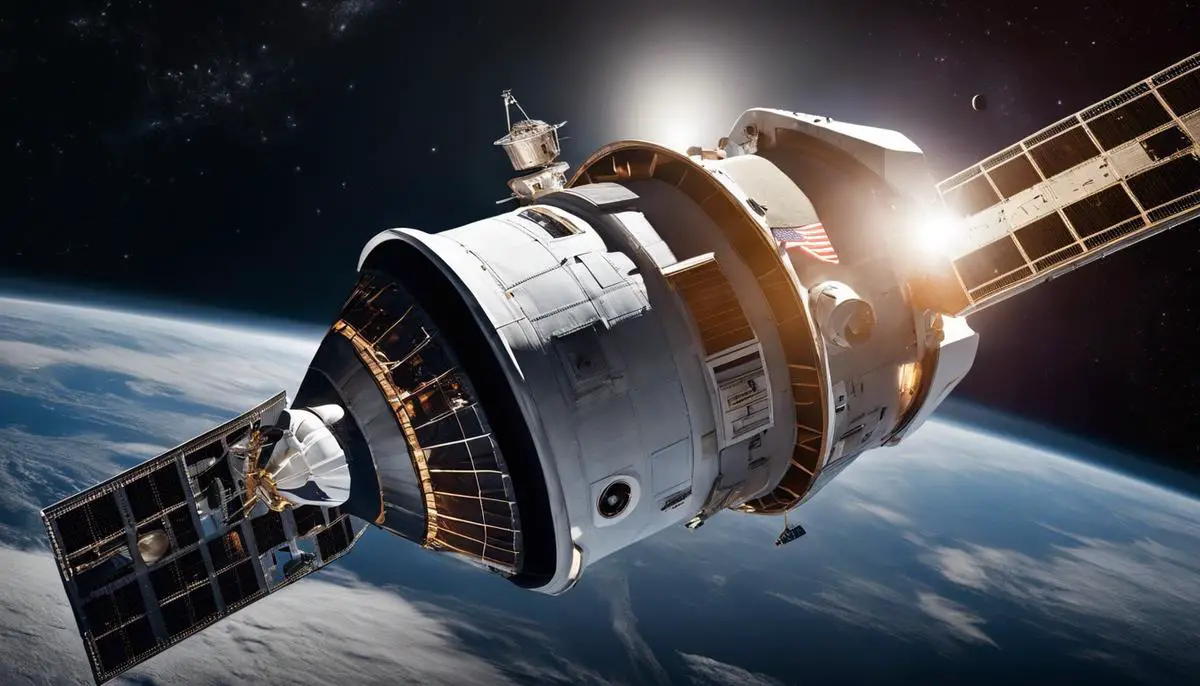When NASA launched the epoch-making Apollo missions, they unwittingly set the stage for groundbreaking advancements in a field absorbing increasing attention – software development. An exhilarating exploration of this unforeseen fallout provides a riveting perspective on the interplay between space exploration and technological evolution. This discussion delves into the evolving role of software in the successful realisation of the Apollo missions, spotlighting the criticality of elements ranging from flight command systems to computational simulations. Concurrently, we embark on a riveting journey to understand the software-related hurdles peppered throughout this momentous venture, unearthing innovative solutions that surmounted technological constraints and ignited advancements in developmental methodologies. The narrative shines a light on the significant contributions of Margaret Hamilton to both the missions and the broader discipline of software engineering, before drawing back to appraise the indelible impact of the Apollo missions on shaping modern software development.
Contents
Evolving Role of Software in Apollo Projects
The Crucial Role of Software in Pioneering Apollo Missions
The Apollo missions, arguably the most expansive scientific projects ever undertaken by humanity, represented a milestone in the incorporation of software in mission-critical systems. Apollo started in an era when software as a discipline was in its nascent stage. Yet, its role in the successful lunar journeys is undeniable and serves as a testament to the transformative potential of software engineering.
Apollo’s Guidance Computer (AGC) was a revolutionary piece of technology, and at the heart of AGC resided a software marvel – the Apollo onboard flight software. Conceived and developed by the Massachusetts Institute of Technology, this software was truly ahead of its time. It innovatively harnessed the concept of ‘priority scheduling’, where tasks requiring immediate attention received processing precedence over less urgent computations. This feature was instrumental in the Apollo 11 mission’s success, as the AGC was able to maintain efficient functionality under stress, prioritizing landing calculations over less critical tasks.
The achievements of the Apollo missions were underpinned by remarkable advances in software error detection and recovery techniques. The Apollo software was designed to combat ‘software bugs’ that could cause system malfunction or failure, for instance in Apollo 14, where a malfunctioning abort switch could have easily triggered an early return. The software’s exceptional ability to bypass this faulty hardware ensured the mission’s continuance to a successful lunar landing.
Human-computer interaction, often taken for granted in today’s touchscreen era, was fundamentally transformed through the Apollo project. The user interface of the AGC comprised of a simple numeric keypad and display, a reflection of minimalist design principles that prioritized function over aesthetics. The crew entered noun-verb pairs, a pioneering effort in the use of a high-level language interface in computer systems.
Moreover, the Apollo missions heralded an era where software became an integral part of safety mechanisms. The notion of ‘software reliability’ was notably foregrounded when considering the Apollo missions were human-rated, meaning that crew safety was paramount. This led to rigorous software testing procedures that built confidence in the dependability of the onboard computer and the life-critical systems it controlled.
It is quite compelling that the relatively limited computational capabilities of the AGC, by today’s standards, were able to pilot the Apollo spacecrafts to lunar landscapes and back. This triumph was a testimony to efficient software design, balancing system constraints whilst ensuring mission-critical operational capability.
Therefore, evaluating the Apollo missions’ grandeur one realizes that software did not merely help ‘realize’ them, but in fact, ‘shaped’ their trajectory in more ways than one. And as we continue to push the frontiers of space exploration today, it’s evident how historical advances in software technology during the Apollo era have paved the way for the sophisticated spacecraft navigation systems of the 21st century. This tale underscores the inextricable link between scientific advancement and software evolution and reaffirms our belief in the limitless potential of software in shaping humankind’s destiny.

Major Challenges and Innovative Solutions
Overcoming Apollo Software Challenges: The Path to Moon and Beyond
In the realm of space exploration, the daring Apollo missions constitute a remarkable juncture, paving the pathway to mastering the moon, but not without a series of software challenges that were surmounted with innovative solutions. It’s imperative to delve into these software-related trials, comprehending the measures undertaken to conquer them, thereby facilitating an understanding of the crucial role played by computer systems in monumental human achievements.
A significant challenge faced was the limited memory capacity. The guidance computer for Apollo had a read-only memory (ROM) of mere 72KB and a random access memory (RAM) of just 4KB. With such constraints, intricate planning of software was paramount. This called for pioneering a new programming language, dubbed ‘assembly’ language, to code programs. Assembly possessed high efficiency, a prerequisite to fit extensive functional capabilities within compact space. Sabermetric practices, paired with the adoption of a minimalist and elegant programming approach, enabled coding within this tiny memory capacity, effectively surpassing the capacity constraint.
Saturation of system capacity was another variant of adversity. The Apollo Guidance Computer (AGC) was the first to utilize an executive scheduler that allocated ‘real time’ according to task priority, utilizing the concept known as priority scheduling. In the critical moments of Apollo 11’s lunar descent, multiple radar data nearly overloaded the computer. But the ingenious priority scheduling technique, causing the computer to drop low-priority tasks and focus solely on landing, proved vital in sustained functionality in dire circumstances.
Hardware failures posed substantial hurdles too. One such instance involved a hardware issue in onboard timers that could potentially abort the mission. The solution emerged in the form of meticulously crafted software, which emulated the operation of the faulty hardware, thereby allowing the mission to continue unabated.
Last ly, constraint of error detection was faced head-on. For a high stake endeavor like a lunar landing, an error, no matter how infinitesimal, could spell disaster. Thus, advanced techniques like parity checking, employed for Apollo Guidance systems, allowed detection of coding errors. In certain instances, errors redirected to the ‘core set’ leaving the critical operations unaffected. This methodology was instrumental in ensuring seamless lunar excursions.
In a big-picture perspective, these intricate solutions to substantial software challenges have not just been a cornerstone for the Apollo missions, but have laid down rigorous groundwork for future space expeditions as well. Harnessing these insights, humanity stands equipped to take more giant leaps, venturing into uncharted territories, proving yet again that even the sky isn’t a limit to discovery and progress.

Margaret Hamilton and Apollo: Pioneering Software Engineering
The Legacy and Lasting Impact of Margaret Hamilton in the Apollo Missions
Beyond the confines of the topics already explored, we must underscore the pivotal role Margaret Hamilton played in this immense endeavor. Hamilton, an innovator and a visionary, was the Director of the Software Engineering Division at MIT’s Instrumentation Laboratory contracted by NASA. Her visionary perspective and her determined problem-solving attitude had an unprecedented role in shaping software engineering as an academic discipline and establishing its professional legitimacy.
Indeed, NASA’s Apollo missions would have remained merely as ambitious concepts, if not for Hamilton’s ground-breaking input. She introduced the concept of asynchronous software, which comprised of “priority scheduling”: a methodology that determined the process of executing multiple tasks based on their importance. This concept proved instrumental in dealing with limited memory capacity. Hamilton fine-tuned this technique, making it possible for the spacecraft’s computer to prioritize essential tasks and put less critical procedures on hold, allowing missions to proceed where they would otherwise have to be aborted.
She was, as well, pivotal in the development of assembly language coding—a technique that commands respect even today. It allowed efficient utilization of the minimal computing resources available in the Apollo guidance system, a critical aspect when resources were premium.
Hamilton’s method of handling hardware failures is also noteworthy. She introduced software emulation as a safeguard against hardware malfunctions—a technique now quotidian, but revolutionary at the time. This technique involves creating a virtual equivalent of a physical device in software, allowing simulations helpful in diagnosing and overcoming hardware problems.
Error detection and correction systems were equally critical and were markedly enhanced under Hamilton’s guidance. The use of parity checking—verifying the reliability of data in the computer—stands out in Hamilton’s contribution to error detection. This technique became a cornerstone in ensuring error-free, reliable software in the constrained memory environment of the Apollo missions.
Remarkably, these innovations didn’t just remain confined within the Apollo program but became an enduring legacy influencing several future space programs. The successful application of Hamilton’s software solutions recalibrated expectations and opened new horizons for addressing software challenges in subsequent space endeavors, profoundly influencing the Mars Rover missions among others.
The breadth and depth of Margaret Hamilton’s contributions to the seminal Apollo missions without a doubt were crucial to their success. Yet, her impact extends far beyond, shaping not only the nascent domain of software engineering but also creating paradigms that continue to inform and guide contemporary and future space explorations. A study of Hamilton’s work, therefore, is an essential sejourne in our understanding of software engineering’s growth as a discipline and the broader narrative of human quest for space exploration.

Legacy of Apollo Missions on Modern Software Development
The Apollo missions were not only about exploration of the cosmos, but also marked significant strides in popping the software development bubble. As an exercise, tracing the evolution of software development methodologies back to Apollo illuminates the profound impact these missions had on modern craft. Indeed, the challenges of engineering software for space travel have constantly nudged the discipline of software development forward, shaping many prevalent methodologies and trends.
A pivotal issue borne from the Apollo missions was working within the constraints of limited memory capacity. To paint a picture, the Apollo Guidance Computer (AGC) had an infinitesimal 64KB of memory, merely a fraction of what modern electronic devices possess. Manoeuvring within such constraints led to a heightened focus on memory-efficient coding, which remains a priority in software development today, where optimizing applications for better performance is still very much in vogue.
Assembly language coding, characterized by low-level machine language, was at the helm of software development during the Apollo missions. This trend has waned over the years due to advancements in higher-level programming languages that offer increased readability and abstraction. However, assembly language is not entirely extinct. It continues to be deployed where granular control over system resources is paramount, such as in device drivers and real-time system applications.
Saturation of system capacity prompted the use of priority scheduling, a trend that still permeates the world of computing today. Although the volume and complexity of tasks have immensely escalated since the Apollo era, priority scheduling remains a vital component, ensuring essential tasks are processed first and thereby enhancing system efficiency.
As technology advanced, it became apparent that hardware alone cannot be relied upon. The Apollo missions responded to this reality early on by implementing software emulation as a fallback for hardware failures. Echoes of this methodology are evident in modern app development, where software emulators are routinely deployed during application testing before being launched in actual device environments.
Parity checking emerged as an essential error detection technique during the Apollo era, offering the ability to identify single-digit errors. This seemingly simple idea of utilizing redundancy to detect errors has been further refined and built upon, playing a crucial role in modern error checking and correction mechanisms.
Moreover, the Apollo missions provided an experimental lab for tinkering with solutions to software challenges posed by space expeditions. Overcoming these hurdles has laid the groundwork for their future counterparts. The Mars Rover missions, for instance, owe a substantial part of their software paradigm to the problem-solving approaches developed during the Apollo era.
Moreover, no discourse on the Apollo missions and software engineering is complete without mentioning Margaret Hamilton. Hamilton, in her role as the Director of the Software Engineering Division at MIT’s Instrumentation Laboratory, indubitably championed integral software practices. Her work serves as a seminal reference for understanding both, the exponential growth of software engineering as a discipline, and humanity’s persistent pursuit of space exploration.
In essence, the Apollo missions have profoundly impacted the field of software development, with their echoes reverberating in present-day practices. Understanding the missions’ influence lends invaluable insights into the highly dynamic trajectory of software development, shedding light on how software as we know it, came to be.

In the larger theatre of progress, the Apollo missions charted an intriguing arc from a race to conquer the final frontier to a powerful catalyst for software development. Chronicling the integral role of software, the innovative workarounds to technological limitations, and the pioneering efforts of game-changers such as Margaret Hamilton, the narrative ties together the significant threads of this remarkable story. Ultimately, the Apollo legacy is etched into the very principles of modern software engineering – from the pursuance of code reusability to the rigours of software testing. The echoes of this extraordinary era continue to reverberate within the hallowed realms of innovation, technology, and software development, reminding us that sometimes, the journey is as significant as the destination.
